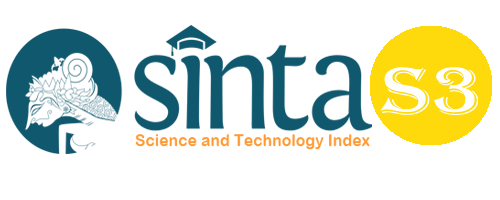The Influence of Business Intelligence Dashboard in Decision-Making Process: A Case Study in Government Agency
Abstract
With the rapid development in big data and business intelligence platforms, the government is required to keep up with the technology in managing the organization's data to give excellent public service. The government as a policy maker should make policies and make a decision based on data rather than just the manager’s intuition. The investment in a business intelligence platform should ease in doing routine and simplify the decision-making process. The objective of this study is to know employee perception on the data visualization available in Indonesian FDA and list the possibilities to improve it. The data used are from primary and secondary data. The primary data get from employee surveys while secondary data is from company reports and other sources on the internet. The analysis using quantitative analysis with ANOVA. Data visualization using color can increase willingness to read and people can faster grab the sense from visuals. This will help a manager digest all the data to make a decision. After conducting the study, the result showed that a business intelligence dashboard could help the employee in providing a brief overview of real-time data in general when needed. The dashboard capability that the employee thinks important is data filtering. Having a business intelligence dashboard can help managers make the decision process faster and more precise.
Keywords
Full Text:
PDFReferences
Bazerman, M.H. (2013). Judgment in Managerial Decision-making. 8th ed. New York: Wiley
Chessell, Oleh Mandy Chessell, et al. (2018). The Journey Continues: From Data Lake to Data-Driven Organization. IBM Redbooks
DalleMule, Leandro; Davenport, Thomas H. (2017) What’s Your Data Strategy?. Harvard Business Review.
El-Askalany, Ahmed. 2019. The difference between #Industry 3.0 and #Industry 4.0. Retrieved on September, 11th 2021 from https://www.linkedin.com/pulse/difference-between-industry-30-40-ahmed
Few, Stephen. (2006). Information Dashboard Design: The Effective Visual Communication of Data. O'Reilly.
Gounder, M. S., Iyer, V. V., & Mazyad, A. A. (2016). A survey on business intelligence tools for university dashboard development. 2016 3rd MEC International Conference on Big Data and Smart City (ICBDSC). doi:10.1109/icbdsc.2016.7460347
Hanschke, I. (2010). Strategic IT Management. doi:10.1007/978-3-642-05034-3
Hansoti, Bhumika, "Business Intelligence Dashboard in Decision-making" (2010). College of Technology Directed Projects. Paper 1
Inmon, W. H. (2005). Building the Data Warehouse. Germany: Wiley.
Kannengiesser U and Gero JS (2019) Design Thinking, Fast and Slow A Framework for Kahneman’s Dual-System Theory in Design.
Kaufmann, L., Meschnig, G., & Reimann, F. (2014). Rational and intuitive decision-making in sourcing teams: Effects on decision outcomes. Journal of Purchasing and Supply Management, 20(2), 104–112. https://doi.org/10.1016/j.pursup.2014.03.003
Kearny, C., Gerber, A., & van der Merwe, A. (2016). Data-driven enterprise architecture and the TOGAF ADM phases. 2016 IEEE International Conference on Systems, Man, and Cybernetics (SMC). doi:10.1109/smc.2016.7844957
Knaflic, C. N. (2015). Storytelling with data: A data visualization guide for business professionals. John Wiley & Sons.Miloslavskaya, Natalia, Alexander Tolstoy, (2016) Big Data, Fast Data and Data Lake Concepts. Procedia Computer Science, Volume 88.
Monfared, J. , Akbari, Z. (2019), 'Using Business Intelligence Capabilities to Improve the Quality of Decision-Making: A Case Study of Mellat Bank', World Academy of Science, Engineering and Technology, Open Science Index 146, International Journal of Economics and Management Engineering, 13(2), 159 - 170.
Mosley M., Brackett M., Earley S.,Henderson D. (2009) : The DAMA Guide to The Data Management Body of Knowledge (DAMA-DMBOK Guide). USA:Technics Publications, LLC.
Pappas, L., & Whitman, L. (2011). Riding the Technology Wave: Effective Dashboard Data Visualization. Human Interface and the Management of Information. Interacting with Information, 249–258. doi:10.1007/978-3-642-21793-7_29
Provost, F., & Fawcett, T. (2013). Data Science and its Relationship to Big Data and Data-Driven Decision-making. Big Data, 1(1), 51–59. doi:10.1089/big.2013.1508
Pusdatin Indonesian FDA. 2020 Annual Report.
Qlik. (2021). “Choosing an analytics solution? Choose a 10-time Gartner Magic Quadrant Leader”. Retrieved from https://www.qlik.com/us/gartner-magic-quadrant-business-intelligence
Shen-Hsieh, A., & Schindl, M. (2002). Data visualization for strategic decision-making. Case Studies of the CHI2002|AIGA Experience Design FORUM on - CHI ’02. doi:10.1145/507752.507756
Sivarajah, U., Kamal, M. M., Irani, Z., & Weerakkody, V. (2017). Critical analysis of Big Data challenges and analytical methods. Journal of Business Research, 70, 263–286. doi:10.1016/j.jbusres.2016.08.001
Starbuck, William & Mezias, John. (2008). Decision-making with Inaccurate, Unreliable Data. 10.1093/oxfordhb/9780199290468.003.0004.
Vijayvargiya, Abhishek. (2009) One-Way Analysis of Variance. Journal of Validation Technology.
DOI: https://doi.org/10.33258/birci.v5i1.4106
Article Metrics
Abstract view : 233 timesPDF - 74 times
Refbacks
- There are currently no refbacks.

This work is licensed under a Creative Commons Attribution-ShareAlike 4.0 International License.

This work is licensed under a Creative Commons Attribution-ShareAlike 4.0 International License.

_.gif)

















_.gif)



